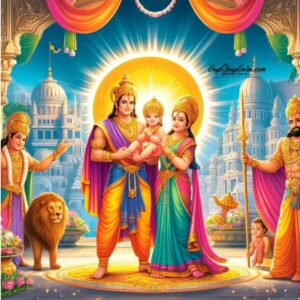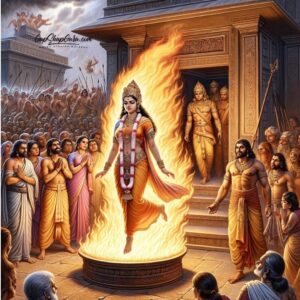Embark on an enchanting voyage into the heart of Indian mythology with “Inspiring Ramayana Stories for Kids.” This collection offers a glimpse into a world where divine heroes battle formidable demons, where loyalty, bravery, and the triumph of good over evil illuminate each tale. Designed with young readers in mind, these stories from the ancient epic, the Ramayana, are not just narratives but lessons in courage, devotion, and morality. As we venture together through these timeless tales, we aim to ignite children’s imaginations, fostering a deep appreciation for cultural heritage and instilling lifelong values. Related: 25 Panchatantra Short Stories In English With Moral For Kids
Inspiring Short Ramayana Stories For Kids
Dive into the depths of ancient wisdom with our carefully selected “Inspiring Ramayana Stories for Kids.” Each story, a jewel from the grand epic of the Ramayana, is polished to shine brightly for young minds, offering both entertainment and enlightenment. These narratives are more than just tales of adventure; they are profound lessons wrapped in the cloak of mythology, relevant across ages and cultures.

As we unfold these stories, we invite children to explore the virtues of honesty, bravery, and righteousness, encouraging them to walk the path of virtue in their own lives. Join us on this journey of discovery, where each story is a step towards understanding the essence of good character and moral integrity.
Birth Story of Lord Rama – Ramayana Stories
Long, long ago, in the kingdom of Ayodhya, a wise and good king named Dasharatha ruled. All his people loved him, but he was sad because he had no children to inherit his throne. He wished more than anything to have a son who could take his place as king one day.

King Dasharatha performed a sacred ceremony to fulfil his wish, praying to the gods for a blessing. The gods, pleased with his devotion, granted him a divine dessert, which he shared with his three queens.
Soon after, the queens became pregnant, and the whole kingdom awaited with excitement. The first queen, Kausalya, gave birth to a beautiful baby boy named Rama. The people of Ayodhya rejoiced for they knew that this child was special. Rama was not only beautiful but also had an aura of goodness and wisdom, even as a child.
As Rama grew up, everyone in the kingdom loved him for his kindness, bravery, and wisdom. He learned quickly and was always ready to help those in need. People knew that one day, he would make a great king, just like his father.
Moral of the Story: The story of Lord Rama’s birth teaches us about the power of faith and the importance of goodwill. Just as King Dasharatha’s faith and good deeds brought him the blessing of a son, our positive actions can bring us good fortune and happiness. Always believe in goodness and keep doing good deeds.
Story of Exile of Lord Rama – Ramayana Stories
Once, in the peaceful kingdom of Ayodhya, the beloved Prince Rama was preparing to become king. However, not everyone in the palace was happy about this. Queen Kaikeyi, one of King Dasharatha’s wives, wanted her own son, Bharata, to become king instead. Influenced by her cunning maid, she reminded King Dasharatha of an old promise he had made to grant her two wishes.

Reluctantly, the king agreed to fulfil her wishes. Heartbroken, he granted her first wish that Bharata should be crowned king. Her second wish was that Rama should be exiled to the forest for fourteen years. King Dasharatha had no choice but to agree, as he had always kept his promises.
When Rama heard about the decision, he accepted it calmly without any anger or sorrow. He believed in respecting and obeying his father’s words, no matter how difficult. So, Rama, along with his devoted wife Sita and loyal brother Lakshmana, left the comforts of the palace and went to live in the forest.
The people of Ayodhya were very sad to see their favourite prince leave. Despite the unfairness of the situation, Rama showed great courage and integrity. He lived in the forest, facing many challenges and dangers, but he always remained true to his values. Related: Unity Is Strength – 5 Inspirational Stories for Kids
Moral of the Story: Rama’s exile teaches us about sacrifice, duty, and respect for one’s parents and promises. Even when faced with tough situations, staying true to one’s principles and treating others with respect can lead to greater strength and character. This story encourages us to face life’s challenges with a brave and noble heart.
Story of Abduction of Mata Sita by Ravana
During their exile in the dense forest, Rama, Sita, and Lakshmana lived simply and peacefully. However, one day, their tranquillity was shattered by the cunning plan of the demon king Ravana. Ravana had heard of Sita’s beauty and goodness and decided to kidnap her.

To distract Rama and Lakshmana, Ravana sent a magical golden deer, which Sita saw and desired. When she asked Rama to capture it for her, he went after the deer, leaving Sita under Lakshmana’s protection. Before he left, Rama instructed Lakshmana not to leave Sita alone under any circumstances.
However, the golden deer was no ordinary deer; it was a demon in disguise. When Rama realized this and shot it, the deer transformed back into a demon and cried out for help in Rama’s voice. Hearing this, Sita became anxious and urged Lakshmana to go help Rama. Despite his reluctance, Lakshmana drew a protective circle around Sita and told her to stay inside it for her safety before he left to find Rama.
With the brothers distracted, Ravana disguised himself as an old sage and approached Sita, asking for alms. Trusting the seemingly harmless old man, Sita stepped out of the protective circle to offer him food. That moment, Ravana revealed his true form and abducted her, taking her away to his kingdom of Lanka. Related: Honesty Is the Best Policy – 5 Short Stories With Moral
Moral of the Story: Sita’s abduction by Ravana teaches us about the dangers of deception and the importance of following wise advice. It reminds us to be cautious and aware of the intentions of strangers and to trust and listen to the guidance of those who care for our safety.
Hanuman’s Leap to Lanka
After Sita was abducted by Ravana, Rama and Lakshmana searched far and wide for her. In their quest, they allied with Hanuman, a devoted and powerful monkey warrior who became Rama’s loyal follower. Hanuman vowed to find Sita and bring news of her safety back to Rama.

To locate Sita, Hanuman needed to reach the island kingdom of Lanka, where Ravana had taken her. This was no small feat, as it required leaping across a vast ocean. Hanuman climbed to the top of a mountain and, with the power of his faith and devotion to Rama, gathered all his strength for the great leap.
As Hanuman soared through the air, he faced many obstacles. A demoness tried to swallow him, thinking him to be a tasty morsel flying across the sea. But Hanuman outsmarted her and continued on his journey. He finally reached Lanka, undetected and ready to find Sita.
In Lanka, Hanuman searched discreetly and finally found Sita in a beautiful garden, guarded and sad. He gave her a ring from Rama as a sign of Rama’s love and the promise that Rama was coming to rescue her. Reassured, Sita gave Hanuman her hair ornament to take back to Rama as proof of her well-being and whereabouts. Related: Birth Story of Lord Krishna: A Tale of Divine Triumph
Moral of the Story: Hanuman’s leap to Lanka teaches us about bravery, devotion, and the strength that comes from faith. Hanuman’s courageous journey shows that no obstacle is too big when you are committed to helping others and standing by your friends. It inspires us to face challenges with courage and to always be loyal and helpful.
Building the Bridge to Lanka
After learning about Sita’s location from Hanuman, Rama prepared to rescue her from Ravana’s clutches. However, the challenge was to reach Lanka, an island far across the sea. To solve this, Rama enlisted the help of his devoted followers, the vanara (monkey) army, which included brave warriors like Hanuman.

The vanaras, under the guidance of Rama and with the blessing of the sea god, began building a bridge to Lanka. This was no ordinary task; it required strength, determination, and unity. The vanaras used rocks and boulders, inscribing them with Rama’s name, which made them float on water due to the power of his name.
Day and night, the vanaras worked, and slowly a bridge started to take shape. This bridge, known as Rama Setu or Adam’s Bridge, was a marvel of teamwork and devotion. It stretched over the ocean, providing a way for Rama and his army to march to Lanka.
Once the bridge was completed, Rama led his army across it to Lanka, ready to face Ravana and bring back Sita. The construction of the bridge was a testament to what can be achieved when everyone works together towards a common goal.
Moral of the Story: The story of building the bridge to Lanka teaches us about cooperation and perseverance. When faced with daunting challenges, working together harmoniously can lead to incredible achievements. This tale encourages us to collaborate with others and to believe in the strength of unity and purpose.
The Battle of Lanka
Once the bridge to Lanka was built, Rama and his mighty army of vanaras (monkeys) prepared for the great battle against Ravana and his forces. The battle was to be fierce, for Ravana was a powerful demon king with a formidable army. But Rama was determined to rescue Sita and bring justice.

As the battle commenced, both sides fought valiantly. Rama, with his bow and arrows, was unstoppable, and his followers, especially Hanuman, showed great heroism. The fighting was intense, with many acts of bravery and skill displayed by warriors on both sides.
Ravana used many magical powers to his advantage, but each time, Rama countered them with his valour and strategic thinking. The battle lasted for several days, with many ups and downs. Rama’s brother Lakshmana was severely wounded during the fight, adding to the drama of the battle. However, with the help of the magical herb brought by Hanuman, Lakshmana was healed, and the battle continued.
In the end, it was Rama who faced Ravana in a final duel. Rama, empowered by the spiritual strength and blessings of the gods, finally defeated Ravana with a powerful arrow that struck his navel, the source of his immortal powers.
Moral of the Story: The Battle of Lanka teaches us about the triumph of good over evil and the importance of fighting for justice. Rama’s victory reminds us that with righteousness, bravery, and the support of friends and family, one can overcome any challenge, no matter how daunting it may seem. This story encourages us to stand up for what is right and to be persistent in our efforts against wrongdoing.
The Loyalty of Vibhishana
In the epic tale of Ramayana, amidst the chaos of the great battle, Vibhishana, the younger brother of the demon king Ravana, shows a significant moment of loyalty and courage. Unlike his brother, Vibhishana is kind-hearted and righteous, and he does not agree with Ravana’s decision to abduct Sita and wage a war against Rama.

Vibhishana tried to advise Ravana to return Sita honourably to Rama and seek peace. However, Ravana, blinded by pride and anger, refused to listen. Feeling disheartened and knowing the righteousness of Rama, Vibhishana made a bold decision. He left Lanka and his royal privileges to join Rama’s cause, seeking refuge in his camp.
Rama, recognizing Vibhishana’s sincerity and the risk he took by leaving his home, warmly welcomed him into his fold. Vibhishana provided Rama with valuable insights into Ravana’s strategies and fortifications, proving instrumental in planning the successful invasion of Lanka.
After the victory, Rama crowned Vibhishana king of Lanka as a reward for his loyalty and support. Vibhishana ruled wisely and justly, bringing peace and prosperity to the land that had been marred by conflict and tyranny under Ravana.
Moral of the Story: The story of Vibhishana’s loyalty teaches us the importance of standing by one’s principles, even when it means facing difficult choices or opposing one’s kin. It shows that true loyalty to righteousness always brings honour and respect. This tale encourages us to be true to our conscience and to choose the path of righteousness, regardless of the challenges it might present.
Fire test of Mata Sita
After the great battle of Lanka, where Rama defeated the evil demon king Ravana, Sita was finally freed. However, despite her joy at being rescued, there was a cloud of doubt among some people about her purity, as she had been held captive in Ravana’s palace for a long time.

Rama, who loved Sita deeply, knew her virtue but needed to address the doubts of the people. So, he asked Sita to prove her purity to clear the doubts of the public. Sita, hurt but determined to show her unwavering fidelity and purity, agreed to undergo a trial by fire. She believed that the fire would not harm her as she had always remained faithful to Rama.
As the people of Ayodhya and the vanara army watched, a fire was prepared. Sita prayed to the fire god, Agni, and confidently stepped into the blazing flames. To everyone’s astonishment, Sita emerged from the fire unharmed, without even a singe on her clothes. The fire god himself appeared and proclaimed Sita’s absolute purity and faithfulness.
Rama joyfully embraced Sita, and all doubts about her were dispelled. The couple was reunited, and their love was stronger than ever. They returned to Ayodhya, where Rama was crowned king, and they ruled wisely and justly for many years.
Moral of the Story: Sita’s fire test teaches us about faith, virtue, and the strength of truth. It shows that truth always triumphs, and those who are virtuous and steadfast in their principles will always emerge unscathed, no matter the challenges they face. This story encourages us to be true to ourselves and steadfast in our beliefs, especially when tested by difficult circumstances.
Story of Lord Rama’s Return to Ayodhya
After the defeat of Ravana and the end of their long exile, Rama, Sita, and Lakshmana prepared to return to their beloved homeland, Ayodhya. The entire kingdom eagerly awaited their return, having missed their rightful prince and his companions dearly.

To guide them on their journey back, the people of Ayodhya lit rows of oil lamps, creating a glowing path of light. This day marked the festival of Diwali, celebrated ever since as a symbol of the victory of light over darkness and good over evil.
Upon arriving in Ayodhya, Rama, Sita, and Lakshmana were greeted with immense joy and celebration. The streets were decorated with flowers and flags, and the air was filled with the sound of music and the cheers of the people. Rama’s return brought great happiness and relief to his people, who had long suffered under the rule of a regent.
Rama was crowned as the king, and his reign marked the beginning of a golden age for Ayodhya. Under his rule, the kingdom prospered, justice was upheld, and peace prevailed. Rama and Sita became symbols of ideal rulers, revered not just in their kingdom but all across the lands.
Moral of the Story: Rama’s return to Ayodhya teaches us about the joy of reunification and the celebration of righteous leadership. It shows that true leadership comes with responsibility, compassion, and respect for one’s subjects. This story encourages us to uphold virtues, celebrate our victories, and strive for peace and prosperity in our communities.
The Coronation of Lord Rama
After Rama’s triumphant return to Ayodhya with Sita and Lakshmana, the whole kingdom buzzed with excitement and joy. The day everyone had eagerly awaited had finally arrived—Rama’s coronation as the King of Ayodhya. It was a day destined to restore dharma and prosperity to the kingdom.

The preparations for the coronation were grand. Streets were decorated with flowers and colourful banners, and joyful music filled the air. People from all corners of the kingdom came to witness the momentous occasion. The air was thick with excitement and happiness as everyone wanted to see their beloved prince assume the throne.
On the day of the coronation, Rama dressed in royal attire, looking every bit the noble king he was destined to be. Wise sages and respected elders conducted the sacred rituals. Rama was anointed with holy waters, signifying his readiness to take on the responsibilities as the ruler of Ayodhya. Amidst chants and hymns, the crown was placed on Rama’s head, and he was officially declared the king.
The people of Ayodhya rejoiced, shouting praises and blessings for their new king. Rama addressed his people, promising to lead with fairness, compassion, and dedication to dharma. His rule, often referred to as Ramarajya, became synonymous with a time of peace, justice, and prosperity, where all citizens were happy and content.
Moral of the Story: The coronation of Rama teaches us about the virtues of a good leader—fairness, compassion, and a strong commitment to justice. It shows that good leadership benefits not just the leader but the entire community, bringing peace and prosperity. This story encourages us to be responsible and just, and to always strive for the greater good in our roles and duties.
These stories from the Ramayana are not just tales of mythical figures and fantastical deeds but are imbued with lessons that resonate deeply with the human experience, offering guidance, inspiration, and wisdom to children and adults alike. Through these narratives, young readers are encouraged to reflect on the virtues of bravery, loyalty, righteousness, and the enduring power of love and goodness in the face of life’s many trials.
FAQs
Why are Ramayana Stories important for kids?
Ramayana Stories are important for kids because they teach fundamental values such as honesty, loyalty, courage, and respect through engaging and memorable narratives. These stories not only entertain but also impart lessons on good versus evil, the importance of duty, and the power of devotion, helping to shape a child’s character and worldview.
Can Ramayana Stories be considered a moral guide for children?
Yes, Ramayana Stories can be considered a moral guide for children. Each story is imbued with ethical teachings and virtues, showcasing the consequences of actions and the importance of living a life grounded in righteousness and moral integrity. They offer a framework for understanding complex concepts of duty, loyalty, and justice in a relatable manner.
How can parents use Ramayana Stories to teach children about cultural heritage?
Parents can use Ramayana Stories as a tool to introduce children to India’s rich cultural heritage and ancient traditions. By sharing these stories, parents can discuss the historical and spiritual significance of the Ramayana, the festival of Diwali, and other cultural practices, thereby instilling a sense of pride and connection to their roots.
What makes Ramayana Stories appealing to kids?
Ramayana Stories appeal to kids because of their captivating narratives, including heroic deeds, magical elements, and intriguing characters. The battles between good and evil, the adventures of deities and demons, and the triumphs of virtue over vice capture the imagination, making these stories both entertaining and educational.
How can Ramayana Stories inspire today’s youth?
Ramayana Stories can inspire today’s youth by demonstrating the timeless nature of truth, duty, and courage. They teach that challenges and adversities can be overcome with determination, integrity, and wisdom. By embodying the virtues of characters like Rama, Sita, and Hanuman, young people can learn to navigate their lives with honour, positively contributing to society.
As our journey through the Captivating Ramayana Stories for Kids comes to a close, we are left with a treasure trove of lessons and virtues illustrated through the epic’s timeless narratives. Each story, rich with adventure, bravery, and wisdom, serves not just as a window into India’s illustrious past but as a beacon guiding young hearts and minds towards the light of righteousness and truth. These tales, woven with the threads of moral integrity, courage, and devotion, are more than mere stories; they are life lessons wrapped in the guise of ancient mythology, relevant even in today’s world.
In concluding our exploration of Interesting Short Stories From Ramayana For Kids, we hope these tales of ancient wisdom light up the path for our young readers, guiding them through life’s challenges with the virtues of courage, loyalty, and righteousness. May these stories inspire you to choose the path of truth and goodness, illuminating the world around you with the bright light of virtue and integrity.
